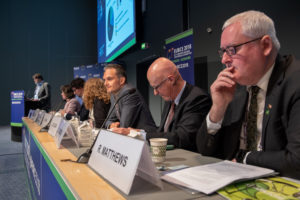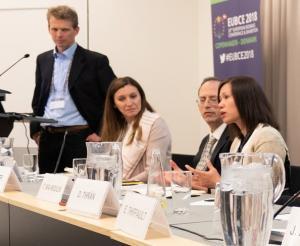by Steve Bi* (Advanced Biofuels USA) Renaissance-era facades capped with green copper patina and orange clay shingles harmonize seamlessly with imaginative, hallmark-of-Scandinavia, hyper-modern structures in downtown Copenhagen.
The city provided the perfect backdrop for this year’s European Biomass Conference & Exhibition (EUBCE 2018), where European and international companies and organizations promoted cutting edge technology and policy research to complement and supplant centuries-old practices in the agricultural sector.
Held from May 14-17, the EUBCE is coordinated by the European Commission’s Joint Research Centre (JRC) and claims to be the leading platform for the collection, exchange and dissemination of scientific and industrial know-how in the field of biomass. Boasting further support from the likes of UNESCO and the World Council for Renewable Energy (WCRE) among others, the EUBCE truly represents one of the world’s most important annual events for the bioenergy community.
The main event of day two ushered all conference attendees into a packed auditorium for a plenary session on climate and sustainability. A minor but sudden medical emergency (all better now) may have kept me in bed on the conference’s opening day, but I wasn’t going to miss this session. This is what I came for.
To no one’s surprise and to my delight, these two hours were dominated by seven letters: LCA and ILUC. Life cycle assessment (LCA) is the widely accepted (though far from perfected) gold standard for quantifying the environmental impacts of producing just about anything, but it has been inextricably linked to bioenergy in recent years.
On the other hand, indirect land use change (ILUC) is a concept that originated from bioenergy research, describing situations where food crops used for fuel production would be replaced by building farms on natural land elsewhere (rainforest in a worst case scenario). In theory, ILUC also results from all other economic activity that occupies arable land, from real estate to oil extraction (and pipelines and spills), but this logic has yet to enter policy debate.
Assessing Life Cycle Assessment
First on the stage was Jacopo Giuntoli of the JRC and the International Council on Clean Transportation (ICCT), presenting his work on assessing LCA as a bioenergy policy support tool, with a focus on forest-based biomass.
His stated motivation for this project was that LCA studies on biofuels have increased exponentially in the past decade, and the adoption of this academic research tool by engineers and companies happened most quickly in the bioenergy industry.
But in all this haste, has the research been developed and deployed in the best way?
Giuntoli’s research team believes in the utility of LCA for informing evidence-based policy making, but they identified a number of criticisms which must first be addressed in current bioenergy LCA methodology and application.
On the research front, traditional LCA studies which purport to be “cradle-to-grave” have excluded biogenic carbon flows, the CO2 uptake by crops or trees from the atmosphere and the subsequent storage in itself and the soil and the eventual release by burning or rotting.
This point was reinforced by Peter Birch Sorensen from the Danish Council on Climate Change. Increased use of forest resources can permanently increase atmospheric CO2 levels, he warned, especially if we are using whole trees. “It is not enough to require replanting,” he warned, since this can only rectify the biogenic carbon balance in the distant future and time is of the essence.
The use of forestry residues also has a net negative effect on the climate, Sorensen asserted, but minimally so compared to logging. Olivier Dubois of the UN Food and Agriculture Organization (FAO) added further insight on this topic, equivocating that residue-based bioenergy is beneficial for the reduced land use requirement, but additional fertilizer would be necessary to replace this natural forest feed.
Giuntoli’s proposal to clarify the true climate impact of a bioenergy source is to always interpret the results with respect to a defined reference point - i.e. the pre-existing or most likely alternative use for the biomass or the land. This would provide a clearer picture of the additional environmental impact (positive or negative) caused by using that particular source of bioenergy.
For example, if the primary competition is with oil and gas extraction, biofuels would represent the more sustainable option. However, lumber production may be favorable to bioenergy harvesting, since the biogenic carbon could then be stored long-term in a building.
The ILUC Dilemma
LCA research has furthermore overlooked the impact of market-mediated effects, or in more familiar parlance, ILUC. Giuntoli is firmly in the camp that these indirect emissions must be accounted through modeling, if even with significant uncertainty, because it is “better to be roughly right than precisely wrong.”
However, this has been a major point of contention within the bioenergy community, and it was on full display during the plenary session. On the other side of the aisle was Inge Stupak of the University of Copenhagen, who maintains that ILUC should be quantified in local, specific contexts rather than through modeling.
When modeling is applied to ILUC, Stupak mentioned that it must be transparent rather than ‘black box,’ referring to studies such as the European Commission’s use of the GLOBIOM model, which kept many of its assumptions and input parameters out of public view.
Dubois elaborated a similarly diplomatic viewpoint on ILUC quantification. He is a major proponent for gathering empirical evidence on actual indirect effects where they are occurring, a learning experience which can help to both predict future ILUC patterns and to generate a set of best practices for mitigating ILUC impacts.
However, Dubois maintains that he’s not out to villainize modeling. He is only compelled to be so vocal about these alternative tools because policy-makers have become so dependent on modeling for all facets of climate legislation that they might as well be wearing horse blinders.
The message is that we must continue to think outside the box, but at the end of the day there’s nothing wrong with acting inside the box if it’s shown to be the best option.
A Happy Medium?
Lorenzo di Lucia of the Imperial College of London arrived at the same conclusions during his research on the ILUC of second generation (2g) biofuels - that modelling efforts have lacked transparency, consistency, and local-level considerations.
He then went on to present his team’s novel approach which may just address each one of these shortcomings: project-level ILUC modeling. The technique is called ILUC_PAST (ILUC Project Assessment Tool), and it is still in the preliminary stages of development.
The first step is to determine what specific activities of the project would require land-use change, bearing in mind the specific conditions of the project (for example, one of their guinea pig projects refused to use any cropland). If some of this land was in use for another economic activity, then the researchers must theoretically map out the five (or more) most likely supply chains which could replace that lost production.
Finally, LCA impact analyses of the increased land use in those five locations would then represent the range of ILUC emissions that would likely result from the project at hand.
The idea is for all agricultural projects (or perhaps any land-intensive activities) in the future will have to submit an ILUC analysis for approval with the grant proposal. This would likely be the best solution for reducing uncertainties in biofuels’ climate impacts, but it would come at the cost of greater labor intensiveness than other alternatives.
At any rate, almost any ILUC mitigation policy would be favorable to the Commission’s desire to categorically phase out “food-based biofuels” due to their “high risk” of ILUC emissions.
Positive Synergies
Christian Ege of the Danish Ecological Council expressed the environmentalist’s perspective that it’s best to avoid using farmable land solely for energy purposes. In fact, a single crop can produce up to three outputs simultaneously: food, energy and soil carbon sequestration. This synergy should be encouraged by policy, not victimized.
At a session titled “Economic Indicators of the EU Bioeconomy,” it was established that despite the youth of the bioeconomy as a concept, it already employs more people (over 17 million) than the average sector in the EU and a turnover of 2 trillion Euros annually.
Barna Kovacs of BioEast pointed out just how young the concept is, as there don’t yet exist any homogenized economic indicators for the bioeconomy, and so for now they must be derived from agriculture and biofuels indicators.
Further complicating things are the many ‘hybrid’ economic sectors which entail a bio-based portion and some non-bio-based activities. But while this might make for difficult accounting, these synergies mean that bioeconomic growth could have an amplified impact on the economy.
So while the Commission is right to harbor concerns over ILUC, it must also consider these positive indirect effects of bioenergy and the potential to quantify and mitigate the negative.
Social Support
Like Robert Matthews of the UK-based Forest Research quipped during his presentation, “A half truth is like a half brick. It has half the weight but it travels twice as far.” These half bricks often contain a grain of truth, but only in specific situations or from a certain perspective.
The EUBCE is such an extraordinary event for stakeholders in the bioenergy industry exactly because one can witness the world’s leading experts debating their differing viewpoints. This helps to put each presentation in context, avoiding the biased takeaways that might result from other more focused, smaller conferences.
However, the unfortunate reality is that we live in a post-truth society, as Geraldine Kutas of the Brazilian Sugarcane Industry Association (UNICA) lamented during her talk on society’s relationship with bioenergy. When both sides constantly employ black and white rhetoric, the truth - resting somewhere in the grayscale - becomes increasingly obscured and socially irrelevant.
For example, Kutas pointed out that survey results can often be contradictory. A recent study found that the majority of society think that bioenergy is both sustainable and a major cause of deforestation. She puts the blame on the media more than anything else for propagating these mixed messages.
“It’s hard to sell positive stories to the media,” Kutas lamented, and this is perhaps truer now than ever before. This is particularly unfortunate because people are primarily concerned with the socioeconomic benefits of bioenergy, as Evelyne Thiffault of Universite Laval found in a survey of Quebec citizens, and there is already robust evidence in places such as Brazil, where Kutas pointed out that sugarcane growing regions are significantly wealthier.
To compound the issue, public perception may just be the most important factor for bioenergy policy, according to a stakeholder survey analysis conducted by Thuy Mai-Moulin of the IEA.
This lies at the core of one of the day’s catchphrases, that the governance of bioenergy sustainability is a “wicked problem.”
A Wicked Problem
Like with any other policy discourse, the people want a simple answer - a dogma to believe in and a straightforward path to follow. After all, it’s an innocent enough question. “Is bioenergy sustainable?”
Well, bioenergy is such a diverse and complex field that the responsible, scientific answer is and always will be: “That depends.”
It depends on the type of feedstock. It depends on where that crop was grown. It depends on how efficiently it utilizes water and land, and on what else those resources could have been used. It depends on the end use and what energy source it replaced. It depends on the economic consequences for other agricultural products. It may even depend on the geopolitical fallout associated with a shifting global energy landscape.
Somehow, rather than feed the public’s (and their representatives’) hunger for sensational and counterproductive “food vs. fuel”-type debates, we must help them to refine their palates.
Policy-makers in particular need to stop waiting for a singular “right answer” to the question because it simply doesn’t exist, warned Alessandro Agostini of the Italian National Agency for New Technologies, Energy and Sustainable Economic Development (ENEA). What makes this such a wicked problem to him is that we can’t even agree on what exactly the problem is since it is constantly changing over time as more knowledge surfaces.
This echoed Inge Stupak’s claim from earlier in the day that “we will never be able to predict all the consequences of bioenergy.” But that mustn’t stop us from using it and understanding it to the best of our ability, because the same can be said of “any other human activity.”
To help reconcile the desire of some lawmakers to achieve perfection, Stupak would like them to recognize sustainability as an aspirational goal, not an operational goal. Novel research findings very often answer certain questions while simultaneously raising new ones. Policy-makers should use the new knowledge to identify the best available opportunities to move the industry forward rather than balk at the ever-present uncertainties and hold it back. To protect against potential missteps, policies must balance regulation with flexibility, she advised.
No Tame Solution
Of all the renewable energy alternatives in the fight against climate change, bioenergy has been and will continue to be the most prevalent and important around the world. Unfortunately, it is also the most complex, to the point that it almost doesn’t make sense to group all the different technologies together under a single term.
It thus follows that we can’t expect to successfully govern the field with a single, blanket policy. As Alessandro Agostini put it, “There can’t be a tame solution to a wicked problem.”
Integrated assessment modeling has grown to become incredibly sophisticated through the years, and it is our best tool available for assessing possible outcomes in the climate-energy-economy nexus. However, the technology is constantly under development, and it can never purport to be 100% accurate.
Therefore, just as new bioenergy technologies keep garnering policy interest as they come to light, so should novel approaches for studying and governing them. Just as different energy sources are better suited for different locations, certain tools should be applied for global scale estimates, others for regional analyses, and yet others for local-scale data collection.
With this complete arsenal at our disposal, it may turn out that, as Jeff Skeer of IRENA said, “The answer to wickedness is cooperation.”
*Steve Bi is a graduate of the Centre international de formation européenne’s (CIFE) Master in Global Energy Transition and Governance and writes for Advanced Biofuels USA, particularly on policy developments in the EU.
**Photos courtesy of EUBCE
Nearly 55,000 articles in our online library!
Use the categories and tags listed below to access the nearly 50,000 articles indexed on this website.
Advanced Biofuels USA Policy Statements and Handouts!
- For Kids: Carbon Cycle Puzzle Page
- Why Ethanol? Why E85?
- Just A Minute 3-5 Minute Educational Videos
- 30/30 Online Presentations
- “Disappearing” Carbon Tax for Non-Renewable Fuels
- What’s the Difference between Biodiesel and Renewable (Green) Diesel? 2020 revision
- How to De-Fossilize Your Fleet: Suggestions for Fleet Managers Working on Sustainability Programs
- New Engine Technologies Could Produce Similar Mileage for All Ethanol Fuel Mixtures
- Action Plan for a Sustainable Advanced Biofuel Economy
- The Interaction of the Clean Air Act, California’s CAA Waiver, Corporate Average Fuel Economy Standards, Renewable Fuel Standards and California’s Low Carbon Fuel Standard
- Latest Data on Fuel Mileage and GHG Benefits of E30
- What Can I Do?
Donate
DonateARCHIVES
- January 2026
- December 2025
- November 2025
- October 2025
- September 2025
- August 2025
- July 2025
- June 2025
- May 2025
- April 2025
- March 2025
- February 2025
- January 2025
- December 2024
- November 2024
- October 2024
- September 2024
- August 2024
- July 2024
- June 2024
- May 2024
- April 2024
- March 2024
- February 2024
- January 2024
- December 2023
- November 2023
- October 2023
- September 2023
- August 2023
- July 2023
- June 2023
- May 2023
- April 2023
- March 2023
- February 2023
- January 2023
- December 2022
- November 2022
- October 2022
- September 2022
- August 2022
- July 2022
- June 2022
- May 2022
- April 2022
- March 2022
- February 2022
- January 2022
- December 2021
- November 2021
- October 2021
- September 2021
- August 2021
- July 2021
- June 2021
- May 2021
- April 2021
- March 2021
- February 2021
- January 2021
- December 2020
- November 2020
- October 2020
- September 2020
- August 2020
- July 2020
- June 2020
- May 2020
- April 2020
- March 2020
- February 2020
- January 2020
- December 2019
- November 2019
- October 2019
- September 2019
- August 2019
- July 2019
- June 2019
- May 2019
- April 2019
- March 2019
- February 2019
- January 2019
- December 2018
- November 2018
- October 2018
- September 2018
- August 2018
- July 2018
- June 2018
- May 2018
- April 2018
- March 2018
- February 2018
- January 2018
- December 2017
- November 2017
- October 2017
- September 2017
- August 2017
- July 2017
- June 2017
- May 2017
- April 2017
- March 2017
- February 2017
- January 2017
- December 2016
- November 2016
- October 2016
- September 2016
- August 2016
- July 2016
- June 2016
- May 2016
- April 2016
- March 2016
- February 2016
- January 2016
- December 2015
- November 2015
- October 2015
- September 2015
- August 2015
- July 2015
- June 2015
- May 2015
- April 2015
- March 2015
- February 2015
- January 2015
- December 2014
- November 2014
- October 2014
- September 2014
- August 2014
- July 2014
- June 2014
- May 2014
- April 2014
- March 2014
- February 2014
- January 2014
- December 2013
- November 2013
- October 2013
- September 2013
- August 2013
- July 2013
- June 2013
- May 2013
- April 2013
- March 2013
- February 2013
- January 2013
- December 2012
- November 2012
- October 2012
- September 2012
- August 2012
- July 2012
- June 2012
- May 2012
- April 2012
- March 2012
- February 2012
- January 2012
- December 2011
- November 2011
- October 2011
- September 2011
- August 2011
- July 2011
- June 2011
- May 2011
- April 2011
- March 2011
- February 2011
- January 2011
- December 2010
- November 2010
- October 2010
- September 2010
- August 2010
- July 2010
- June 2010
- May 2010
- April 2010
- March 2010
- February 2010
- January 2010
- December 2009
- November 2009
- October 2009
- September 2009
- August 2009
- July 2009
- June 2009
- May 2009
- April 2009
- March 2009
- February 2009
- January 2009
- December 2008
- November 2008
- October 2008
- September 2008
- August 2008
- July 2008
- June 2008
- May 2008
- April 2008
- March 2008
- February 2008
- January 2008
- December 2007
- November 2007
- October 2007
- September 2007
- August 2007
- June 2007
- February 2007
- January 2007
- October 2006
- April 2006
- January 2006
- April 2005
- December 2004
- November 2004
- December 1987
CATEGORIES
- About Us
- Advanced Biofuels Call to Action
- Aviation Fuel/Sustainable Aviation Fuel (SAF)
- BioChemicals/Renewable Chemicals
- BioRefineries/Renewable Fuel Production
- Business News/Analysis
- Cooking Fuel
- Education
- 30/30 Online Presentations
- Competitions, Contests
- Earth Day 2021
- Earth Day 2022
- Earth Day 2023
- Earth Day 2024
- Earth Day 2025
- Executive Training
- Featured Study Programs
- Instagram TikTok Short Videos
- Internships
- Just a Minute
- K-12 Activities
- Mechanics training
- Online Courses
- Podcasts
- Scholarships/Fellowships
- Teacher Resources
- Technical Training
- Technician Training
- University/College Programs
- Events
- Coming Events
- Completed Events
- More Coming Events
- Requests for Speakers, Presentations, Posters
- Requests for Speakers, Presentations, Posters Completed
- Webinars/Online
- Webinars/Online Completed; often available on-demand
- Federal Agency/Executive Branch
- Agency for International Development (USAID)
- Agriculture (USDA)
- Commerce Department
- Commodity Futures Trading Commission
- Congressional Budget Office
- Defense (DOD)
- Air Force
- Army
- DARPA (Defense Advance Research Projects Agency)
- Defense Logistics Agency
- Marines
- Navy
- Education Department
- Energy (DOE)
- Environmental Protection Agency
- Federal Energy Regulatory Commission (FERC)
- Federal Reserve System
- Federal Trade Commission
- Food and Drug Administration
- General Services Administration
- Government Accountability Office (GAO)
- Health and Human Services (HHS)
- Homeland Security
- Housing and Urban Development (HUD)
- Interior Department
- International Trade Commission
- Joint Office of Energy and Transportation
- Justice (DOJ)
- Labor Department
- National Academies of Sciences Engineering Medicine
- National Aeronautics and Space Administration
- National Oceanic and Atmospheric Administration
- National Research Council
- National Science Foundation
- National Transportation Safety Board (NTSB)
- Occupational Safety and Health Administration
- Overseas Private Investment Corporation
- Patent and Trademark Office
- Securities and Exchange Commission
- State Department
- Surface Transportation Board
- Transportation (DOT)
- Federal Aviation Administration
- National Highway Traffic Safety Administration (NHTSA)
- Pipeline and Hazardous Materials Safety Admin (PHMSA)
- Treasury Department
- U.S. Trade Representative (USTR)
- White House
- Federal Legislation
- Federal Litigation
- Federal Regulation
- Feedstocks
- Agriculture/Food Processing Residues nonfield crop
- Alcohol/Ethanol/Isobutanol
- Algae/Other Aquatic Organisms/Seaweed
- Atmosphere
- Carbon Dioxide (CO2)
- Field/Orchard/Plantation Crops/Residues
- Forestry/Wood/Residues/Waste
- hydrogen
- Manure
- Methane/Biogas
- methanol/bio-/renewable methanol
- Not Agriculture
- RFNBO (Renewable Fuels of Non-Biological Origin)
- Seawater
- Sugars
- water
- Funding/Financing/Investing
- grants
- Green Jobs
- Green Racing
- Health Concerns/Benefits
- Heating Oil/Fuel
- History of Advanced Biofuels
- Infrastructure
- Aggregation
- Biofuels Engine Design
- Biorefinery/Fuel Production Infrastructure
- Carbon Capture/Storage/Use
- certification
- Deliver Dispense
- Farming/Growing
- Precursors/Biointermediates
- Preprocessing
- Pretreatment
- Terminals Transport Pipelines
- International
- Abu Dhabi
- Afghanistan
- Africa
- Albania
- Algeria
- Angola
- Antarctica
- Arctic
- Argentina
- Armenia
- Aruba
- Asia
- Asia Pacific
- Australia
- Austria
- Azerbaijan
- Bahamas
- Bahrain
- Bangladesh
- Barbados
- Belarus
- Belgium
- Belize
- Benin
- Bermuda
- Bhutan
- Bolivia
- Bosnia and Herzegovina
- Botswana
- Brazil
- Brunei
- Bulgaria
- Burkina Faso
- Burundi
- Cambodia
- Cameroon
- Canada
- Caribbean
- Central African Republic
- Central America
- Chad
- Chile
- China
- Colombia
- Congo
- Congo, Democratic Republic of
- Costa Rica
- Croatia
- Cuba
- Cyprus
- Czech Republic
- Denmark
- Dominican Republic
- Dubai
- Ecuador
- Egypt
- El Salvador
- Equatorial Guinea
- Estonia
- Eswatini/Swaziland
- Ethiopia
- European Union (EU)
- Fiji
- Finland
- France
- French Guiana
- Gabon
- Georgia
- Germany
- Ghana
- Global South
- Greece
- Greenland
- Grenada
- Guatemala
- Guinea
- Guyana
- Haiti
- Honduras
- Hong Kong
- Hungary
- Iceland
- India
- Indonesia
- Iran
- Iraq
- Ireland
- Israel
- Italy
- Ivory Coast
- Jamaica
- Japan
- Jersey
- Jordan
- Kazakhstan
- Kenya
- Korea
- Kosovo
- Kuwait
- Laos
- Latin America
- Latvia
- Lebanon
- Liberia
- Lithuania
- Luxembourg
- Macedonia
- Madagascar
- Malawi
- Malaysia
- Maldives
- Mali
- Malta
- Marshall Islands
- Mauritania
- Mauritius
- Mexico
- Middle East
- Moldova
- Monaco
- Mongolia
- Morocco
- Mozambique
- Myanmar/Burma
- Namibia
- Nepal
- Netherlands
- New Guinea
- New Zealand
- Nicaragua
- Niger
- Nigeria
- North Africa
- North America
- North Korea
- Northern Ireland
- Norway
- Oman
- Pakistan
- Panama
- Papua New Guinea
- Paraguay
- Peru
- Philippines
- Poland
- Portugal
- Qatar
- Republic of
- Romania
- Russia
- Rwanda
- Saudi Arabia
- Scotland
- Senegal
- Serbia
- Sierra Leone
- Singapore
- Slovakia/Slovak Republic
- Slovenia
- Solomon Islands
- South Africa
- South America
- South Korea
- South Sudan
- Southeast Asia
- Spain
- Sri Lanka
- Sudan
- Suriname
- Sweden
- Switzerland
- Taiwan
- Tanzania
- Thailand
- Timor-Leste
- Togo
- Trinidad and Tobago
- Tunisia
- Turkey
- Uganda
- UK (United Kingdom)
- Ukraine
- United Arab Emirates UAE
- Uruguay
- Uzbekistan
- Vatican
- Venezuela
- Vietnam
- Wales
- Zambia
- Zanzibar
- Zimbabwe
- Marine/Boat Bio and Renewable Fuel/MGO/MDO/SMF
- Marketing/Market Forces and Sales
- Opinions
- Organizations
- Original Writing, Opinions Advanced Biofuels USA
- Policy
- Presentations
- Biofuels Digest Conferences
- DOE Conferences
- Bioeconomy 2017
- Bioenergy2015
- Biomass2008
- Biomass2009
- Biomass2010
- Biomass2011
- Biomass2012
- Biomass2013
- Biomass2014
- DOE Project Peer Review
- Other Conferences/Events
- R & D Focus
- Carbon Capture/Storage/Use
- Co-Products
- Feedstock
- Logistics
- Performance
- Process
- Vehicle/Engine/Motor/Aircraft/Boiler/Ship
- Yeast
- Railroad/Train/Locomotive Fuel
- Resources
- Books Web Sites etc
- Business
- Definition of Advanced Biofuels
- Find Stuff
- Government Resources
- Scientific Resources
- Technical Resources
- Tools/Decision-Making
- Rocket/Missile Fuel
- Sponsors
- States
- Alabama
- Alaska
- Arizona
- Arkansas
- California
- Colorado
- Connecticut
- Delaware
- Florida
- Georgia
- Hawai'i
- Idaho
- Illinois
- Indiana
- Iowa
- Kansas
- Kentucky
- Louisiana
- Maine
- Maryland
- Massachusetts
- Michigan
- Midwest
- Minnesota
- Mississippi
- Missouri
- Montana
- Native American tribal nation lands
- Nebraska
- Nevada
- New Hampshire
- New Jersey
- New Mexico
- New York
- North Carolina
- North Dakota
- Ohio
- Oklahoma
- Oregon
- Pennsylvania
- Puerto Rico
- Rhode Island
- South Carolina
- South Dakota
- Tennessee
- Texas
- Utah
- Vermont
- Virginia
- Washington
- Washington DC
- West Coast
- West Virginia
- Wisconsin
- Wyoming
- Sustainability
- Uncategorized
- What You Can Do
tags
© 2008-2023 Copyright Advanced BioFuels USA. All Rights reserved.










.jpg)





Comments are closed.